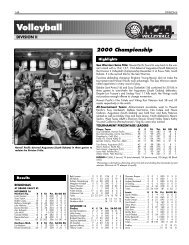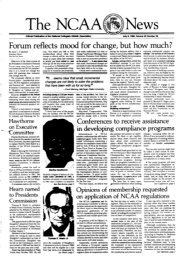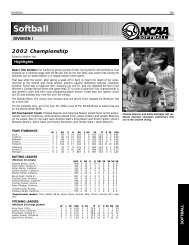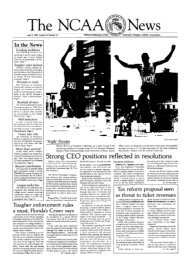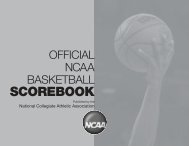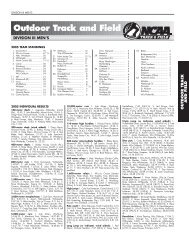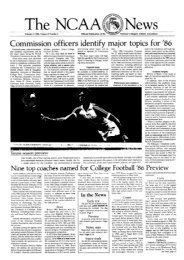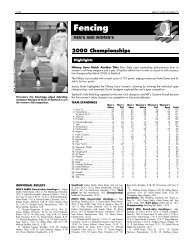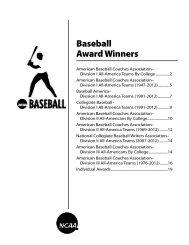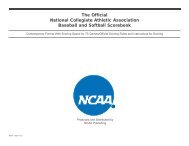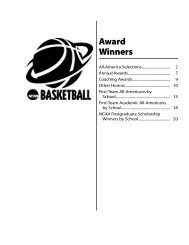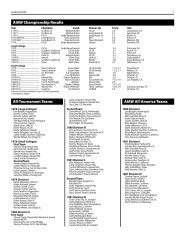Sports Medicine Handbook - NCAA
Sports Medicine Handbook - NCAA
Sports Medicine Handbook - NCAA
Create successful ePaper yourself
Turn your PDF publications into a flip-book with our unique Google optimized e-Paper software.
9. Student-athletes should be educated<br />
on the signs and symptoms of<br />
EHS, such as: elevated core temperature,<br />
weakness, cramping, rapid and<br />
weak pulse, pale or flushed skin,<br />
excessive fatigue, nausea, unsteadiness,<br />
disturbance of vision, mental<br />
confusion and incoherency. If heat<br />
stroke is suspected, prompt emergency<br />
treatment is recommended.<br />
When training in hot and/or humid<br />
conditions, student-athletes should<br />
train with a partner or be under<br />
observation by a coach or<br />
athletic trainer.<br />
First aid for<br />
heat illness<br />
Heat exhaustion—Heat exhaustion<br />
is a moderate illness characterized<br />
by the inability to sustain adequate<br />
cardiac output, resulting from strenuous<br />
physical exercise and environmental<br />
heat stress. Symptoms usually<br />
include profound weakness and<br />
exhaustion, and often dizziness, syncope,<br />
muscle cramps, nausea and a<br />
core temperature below 104 degrees<br />
Fahrenheit with excessive sweating<br />
and flushed appearance. First aid<br />
should include removal from activity,<br />
taking off all equipment and placing<br />
the student-athlete in a cool,<br />
shaded environment. Fluids should<br />
be given orally. Core temperature<br />
and vital signs should be serially<br />
assessed. The student-athlete should<br />
be cooled by ice immersion and ice<br />
towels, and use of IV fluid replacement<br />
should be determined by a<br />
physician. Although rapid recovery<br />
is typical, student-athletes should not<br />
be allowed to practice or compete<br />
for the remainder of that day.<br />
Exertional Heatstroke—Heatstroke<br />
is a medical emergency. Medical<br />
care should be obtained at once; a<br />
delay in treatment can be fatal. This<br />
condition is characterized by a very<br />
high body temperature (104 degrees<br />
Fahrenheit or greater) and the<br />
POTENTIAL RISK FACTORS<br />
As identified throughout Guideline 2c, the following are potential risk factors<br />
associated with heat illness:<br />
1. Intensity of exercise. This is the leading factor that can increase core body<br />
temperature higher and faster than any other.<br />
2. environmental conditions. Heat and humidity combine for a high wet-bulb<br />
globe temperature that can quickly raise the heat stress on the body.<br />
3. duration and frequency of exercise. Minimize multiple practice<br />
sessions during the same day and allow at least three hours of recovery<br />
between sessions.<br />
4. dehydration. Fluids should be readily available and consumed to aid in the<br />
body’s ability to regulate itself and reduce the impact of heat stress.<br />
5. nutritional supplements. Nutritional supplements may contain stimulants,<br />
such as ephedrine, ma huang or high levels of caffeine.* These substances can<br />
have a negative impact on hydration levels and/or increase metabolism and heat<br />
production. They are of particular concern in people with underlying medical<br />
conditions such as sickle cell trait, hypertension, asthma and thyroid dysfunction.<br />
6. medication/drugs. Certain medications and drugs have similar effects as<br />
nutritional supplements. These substances may be ingested through over-thecounter<br />
or prescription medications, recreational drugs, or consumed in food.<br />
Examples include antihistamines, decongestants, certain asthma medications,<br />
Ritalin, diuretics and alcohol.<br />
7. medical conditions. Examples include illness with fever, gastro-intestinal<br />
illness, previous heat illness, obesity or sickle cell trait.<br />
8. acclimatization/fitness level. Lack of acclimatization to the heat or poor<br />
conditioning.<br />
9. clothing. Dark clothing absorbs heat. Moisture wicking-type material<br />
helps dissipate heat.<br />
10. Protective equipment. Helmets, shoulder pads, chest protectors, and thigh<br />
and leg pads interfere with sweat evaporation and increase heat retention.<br />
11. limited knowledge of heat illness. Signs and symptoms can include<br />
elevated core temperature, pale or flushed skin, profound weakness, muscle<br />
cramping, rapid weak pulse, nausea, dizziness, excessive fatigue, fainting,<br />
confusion, visual disturbances and others.<br />
*NOTE: Stimulant drugs such as amphetamines, ecstasy, ephedrine and caffeine are on<br />
the <strong>NCAA</strong> banned substance list and may be known by other names. A complete list of<br />
banned drug classes can be found on the <strong>NCAA</strong> website at <strong>NCAA</strong>.org/health-safety.<br />
student-athlete likely will still be<br />
sweating profusely at the time of<br />
collapse, but may have hot, dry skin,<br />
which indicates failure of the<br />
primary temperature-regulating<br />
mechanism (sweating), and CNS<br />
dysfunction (e.g., altered<br />
consciousness, seizure, coma). First<br />
aid includes activation of the<br />
emergency action plan, assessment<br />
of core temperature/vital signs and<br />
Prevention of Heat Illness<br />
immediate cooling of the body with<br />
cold water immersion. Another<br />
method for cooling includes using<br />
cold, wet ice towels on a rotating<br />
basis. Student-athletes who incur<br />
heatstroke should be hospitalized and<br />
monitored carefully. The NATA’s<br />
Inter-Association Task Force<br />
recommends, “cool first, transport<br />
second” in these situations (see<br />
reference No. 7).<br />
35



